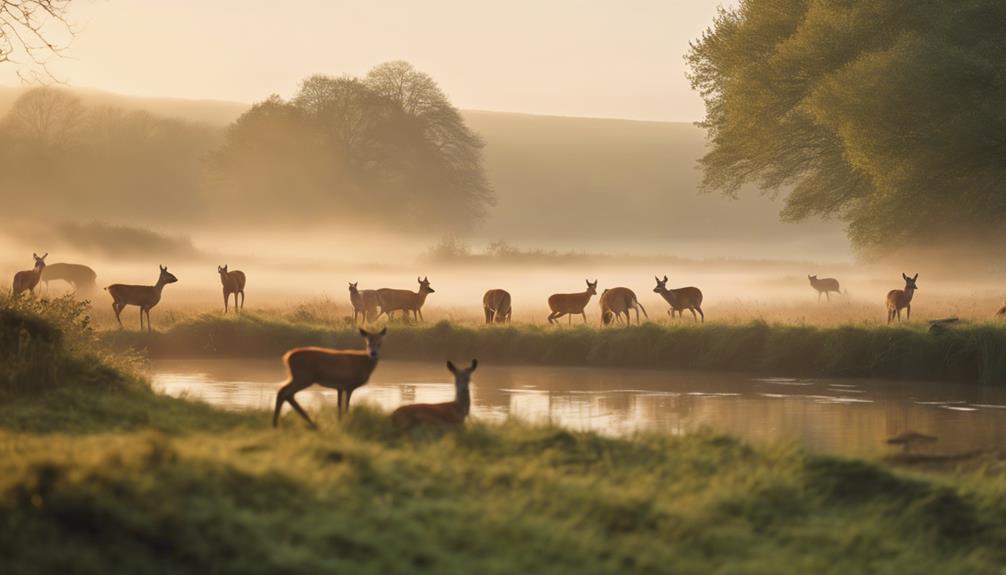Why Choose Staffordshire for Wildlife Photography?
Choose Staffordshire for wildlife photography because it offers a stunning variety of habitats. You'll find woodlands, wetlands, heathlands, and meadows, each teeming with unique wildlife like kingfishers and buzzards. The Peak District's preserved landscapes are perfect for capturing peregrine falcons and red deer. Cannock Chase's forests and moorlands change beautifully with the seasons, adding diverse elements to your shots. Nature reserves such as Doxey Marshes provide well-maintained trails, enabling close encounters with birds and mammals. Whether you're into bird watching at Tittesworth Reservoir or photographing rare plants in wetlands, Staffordshire promises rich and rewarding photographic adventures. Discover more about what awaits you.
Key Points to Note
- Staffordshire's diverse habitats like woodlands, wetlands, and heathlands host unique flora and fauna for varied wildlife photography.
- Nature reserves such as Doxey Marshes and Trentham Gardens offer close encounters with birds and mammals.
- The Peak District's well-preserved environments feature species like peregrine falcons and red deer against stunning natural backdrops.
- Cannock Chase's seasonal changes provide photographers with varied and dynamic scenic opportunities.
- Prime bird watching locations like Tittesworth Reservoir and Chasewater Country Park are ideal for capturing birds in their natural settings.
Varied Habitats
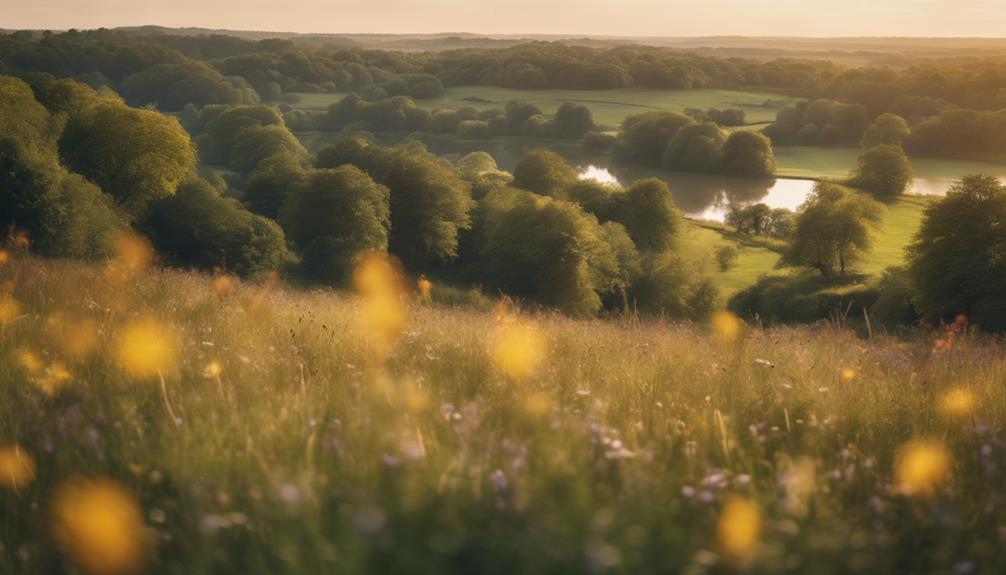
Staffordshire's diverse habitats, including woodlands, wetlands, heathlands, and meadows, offer you a wealth of opportunities for stunning wildlife photography. Each of these environments hosts unique flora and fauna, guaranteeing every photographic adventure is distinct and thrilling.
In the wetlands, you'll find wetland wonders like the elusive kingfisher darting over the water's surface. Nature reserves such as Doxey Marshes and Loynton Moss provide perfect settings to capture these moments.
Moving to the heathlands, the heathland highlights include sightings of buzzards soaring high and foxes sneaking through the undergrowth. These areas offer a raw, untamed beauty that translates into enthralling photographs.
The meadows of Staffordshire are truly magical, with wildflowers blooming and deer grazing in the early morning mist. This meadow magic creates serene and picturesque scenes that are perfect for your portfolio.
Don't forget the woodlands, where woodland wonders await. Owls hidden in the trees and badgers foraging at dusk make for compelling subjects. The changing seasons add a dynamic backdrop, allowing you to capture the same location in different lights and moods.
Staffordshire's varied landscapes ensure that you'll always find new and exciting subjects to photograph, making every trip rewarding.
Peak District Wildlife
Have you ever imagined capturing the majesty of peregrine falcons or the grace of red deer in the breathtaking landscapes of the Peak District? The Peak District in Staffordshire offers an unparalleled experience for wildlife photography enthusiasts. Here, you'll witness diverse wildlife behaviour against stunning backdrops, making each shot a perfect blend of nature and artistry.
The region is a haven for bird species like red grouse and golden plovers, ideal for birdwatching and photography. Keep your camera ready to capture the essential movements of kestrels or the serene beauty of mountain hares. The Peak District's rich biodiversity ensures you'll always find something fascinating to photograph.
When you're framing your shots, the landscape composition plays an essential role. From rolling hills to picturesque valleys, the Peak District's varied terrains provide the perfect settings for capturing wildlife in their natural habitats. The National Park status of the area means you're shooting in well-preserved environments, ensuring the wildlife thrives and your photography opportunities are abundant.
Cannock Chase Landscapes
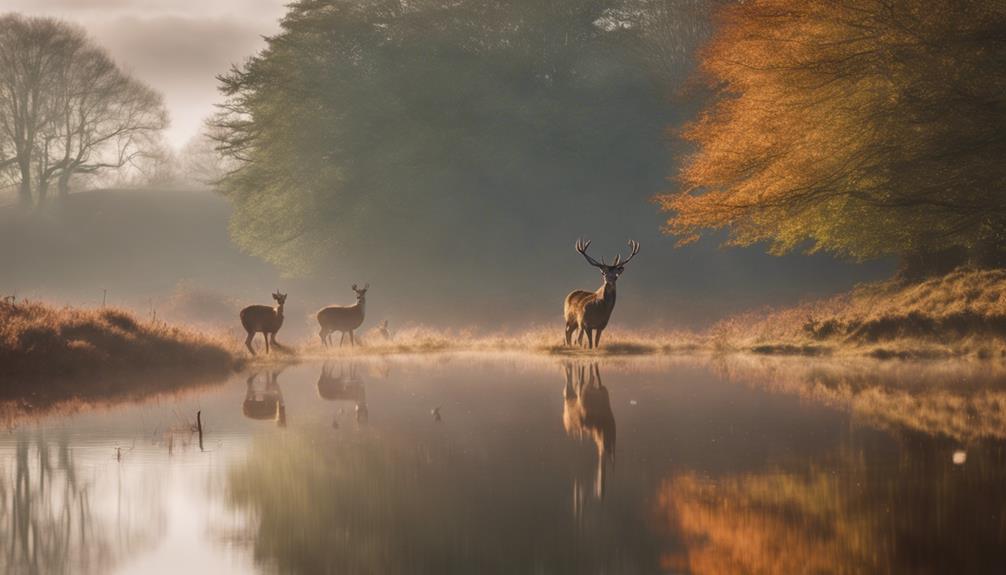
When you explore Cannock Chase, you'll find a rich tapestry of landscapes, from dense forests to open moorlands and peaceful marshes.
Each season brings its own picturesque beauty, offering unique opportunities for capturing stunning photographs. Whether it's the vibrant colours of autumn or the fresh greens of spring, Cannock Chase's diverse habitats provide a perfect backdrop for your wildlife photography adventures.
Diverse Natural Habitats
In Cannock Chase, you'll find a stunning array of natural habitats perfect for wildlife photography, including woodlands, heathlands, and wetlands. These diverse landscapes offer endless opportunities for habitat exploration, allowing you to capture the rich wildlife diversity that Staffordshire has to offer.
From the dense, ancient woodlands teeming with deer and birds, to the open heathlands where insects and small mammals thrive, Cannock Chase is a treasure trove for nature enthusiasts.
The variety of flora and fauna you'll encounter makes ecosystem photography particularly rewarding here. Imagine framing a shot of a majestic deer against a backdrop of lush woodlands or capturing the vibrant colours of wildflowers amidst the heathlands.
The wetlands offer their own unique charm, with reflective waters that provide a serene setting for photographing waterfowl and other aquatic life.
Exploring Cannock Chase not only allows you to experience different lighting conditions and backgrounds, but also gives you a sense of belonging to a community of wildlife photographers who cherish this Area of Outstanding Natural Beauty.
Seasonal Scenic Beauty
Cannock Chase undergoes transformations throughout the seasons, each one offering its own unique scenic beauty perfect for wildlife photography. In autumn, the landscape bursts with seasonal colour palettes of reds, oranges, and yellows, providing a vibrant backdrop to capture wildlife behaviour.
Winter brings a serene, almost magical quality with snow-dusted trees and frozen ponds, ideal for experimenting with weather effects and lighting techniques.
Spring revitalises the area with blossoming flowers and fresh greenery, creating lively settings for photographing new wildlife activity.
Summer, with its lush, dense foliage, offers ample opportunities to capture animals in their natural habitats.
- Autumn's colours: Perfect for capturing dynamic wildlife behaviour against vibrant backdrops.
- Winter's tranquillity: Great for mastering lighting techniques amidst serene, snowy landscapes.
- Spring's renewal: Ideal for documenting new life and seasonal colour palettes.
Cannock Chase's ever-changing scenery and varied lighting conditions provide endless photographic possibilities. Misty mornings and golden sunsets add a magical touch, enhancing your wildlife shots.
Visiting Cannock Chase allows you to capture nature's beauty in different moods and settings, making it a perfect location to diversify and enrich your wildlife photography portfolio. Whether you're a seasoned photographer or just starting, you'll find belonging in this picturesque, ever-changing landscape.
Nature Reserves
Explore Staffordshire's nature reserves for a wildlife photography experience that offers diverse habitats and abundant species. You'll find places like Doxey Marshes, Apedale Community Country Park, and Trentham Gardens, each presenting unique opportunities for nature exploration and wildlife encounters. These reserves are perfect for capturing the beauty of various ecosystems, from meadows and lakes to wetlands.
In Staffordshire's nature reserves, you can spot and photograph a wide range of wildlife. Bird enthusiasts will delight in sightings of kingfishers, herons, and warblers. Mammal lovers can expect to encounter foxes, deer, and even bats. The well-maintained trails and observation points make it possible for you to get close to these creatures without disturbing their natural behaviour, ensuring that your photography experience is both rewarding and respectful to the environment.
Choosing Staffordshire for your wildlife photography not only offers you a chance to immerse yourself in nature but also to contribute to the conservation and appreciation of local wildlife. By exploring these reserves, you join a community of nature lovers dedicated to preserving the natural beauty and biodiversity of Staffordshire.
Wetlands and Woodlands
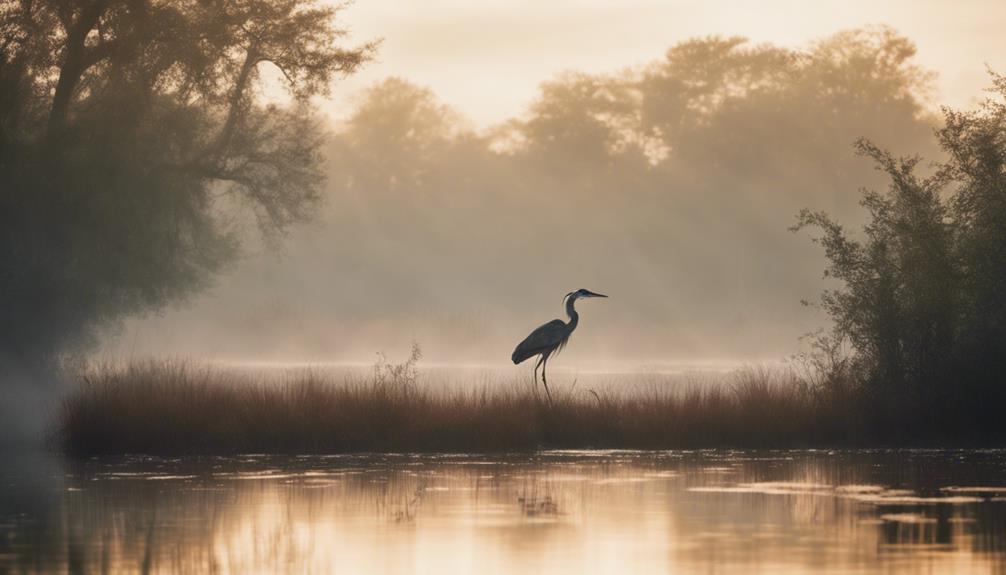
When you're exploring Staffordshire's wetlands and woodlands, you'll find prime birdwatching hotspots that attract numerous species year-round. These areas are also home to diverse plant species, creating rich habitats that support a variety of wildlife.
Don't miss the chance to photograph rare and protected species in these scenic environments, capturing moments that highlight the county's incredible biodiversity.
Birdwatching Locations
Staffordshire's wetlands and woodlands, such as Chasewater and Cannock Chase, offer excellent spots for birdwatching where you can observe a variety of bird species in their natural environments. Whether you're a keen birdwatcher or a dedicated photographer, these locations present plenty of opportunities.
To enhance your experience, consider these birdwatching tips and photography techniques:
- Patience and Timing: Birds are most active during sunrise and sunset. Getting there early or staying late can increase your chances of capturing unique behaviours.
- Know the Seasons: Understanding bird migration patterns and nesting habits helps you plan your visits during peak activity periods.
- Use the Right Gear: A telephoto lens and binoculars are essential for capturing distant shots without disturbing the birds.
Chasewater's wetlands attract waterfowl, while Cannock Chase's woodlands are a habitat for a variety of woodland birds. The different habitats ensure you'll encounter a range of species throughout the year. Observing birds feeding, nesting, or migrating can be both exciting and educational.
Diverse Plant Species
Beyond the avian wonders, Staffordshire's wetlands and woodlands also offer a stunning variety of plant species that are perfect subjects for wildlife photography.
As you explore these habitats, you'll discover botanical wonders that showcase impressive plant diversity. Whether you're new to flora photography or a seasoned pro, Staffordshire's landscapes provide endless opportunities to capture nature's beauty.
In the wetlands, you'll find a rich ecosystem brimming with aquatic plants. These areas are teeming with life, offering you a chance to photograph not just the plants but the intricate relationships within this habitat. From vibrant water lilies to delicate reeds, the wetlands are a treasure trove for any wildlife photographer.
Meanwhile, Staffordshire's woodlands present an alluring mix of ancient and new growth forests. These woods are home to diverse plant species, each contributing to the area's dynamic environment. Imagine photographing the lush undergrowth, towering trees, and seasonal blooms that make these woodlands so enchanting.
Rare Wildlife Encounters
In Staffordshire's wetlands and woodlands, you'll come across rare wildlife that provides unforgettable photographic moments. The county's varied ecosystems are a sanctuary for nature photography, offering a unique mix of habitats where you can photograph a range of species in their natural environments.
Wetlands in Staffordshire are bustling with bird species and aquatic life. You'll have the opportunity to photograph elusive birds such as the bittern or the colourful kingfisher.
Woodlands, on the other hand, support a diverse range of mammals, birds, and insects. Picture capturing the delicate flutter of butterflies or the shy glance of a deer through your camera lens.
Getting involved in wildlife tracking and wildlife rehabilitation efforts in these areas also enables you to contribute to wildlife conservation, making your photography more than just a hobby, but a meaningful activity.
- Birdwatching Opportunities: Spot rare birds like bitterns and kingfishers.
- Diverse Mammal Sightings: Capture images of deer, foxes, and badgers.
- Insect Photography: Document the intricate details of butterflies, beetles, and more.
Bird Watching Locations
You'll find a variety of prime bird watching spots in Staffordshire, including Tittesworth Reservoir, Consall Nature Park, and Chasewater Country Park. These locations are perfect for observing diverse avian species in their natural habitats.
When visiting these spots, it's helpful to have some bird watching tips in mind. Be patient and move slowly to avoid startling the birds. Bring binoculars and a field guide to help identify species.
For those interested in bird photography techniques, Staffordshire offers ample opportunities. Use a telephoto lens to capture close-up shots without disturbing the birds. Early mornings or late afternoons provide the best lighting conditions for stunning photos. Pay attention to bird behaviour; recognising patterns can help you anticipate their movements and get that perfect shot.
At Tittesworth Reservoir, you might spot kingfishers and herons, while Consall Nature Park is home to warblers and other woodland species. Chasewater Country Park attracts a variety of waterfowl.
For rarer sightings, head to Rudyard Lake or Blithfield Reservoir, where ospreys and red kites have been seen.
Staffordshire's rich biodiversity and picturesque landscapes make it an inviting destination for bird watchers and photographers alike.
Mammal Photography
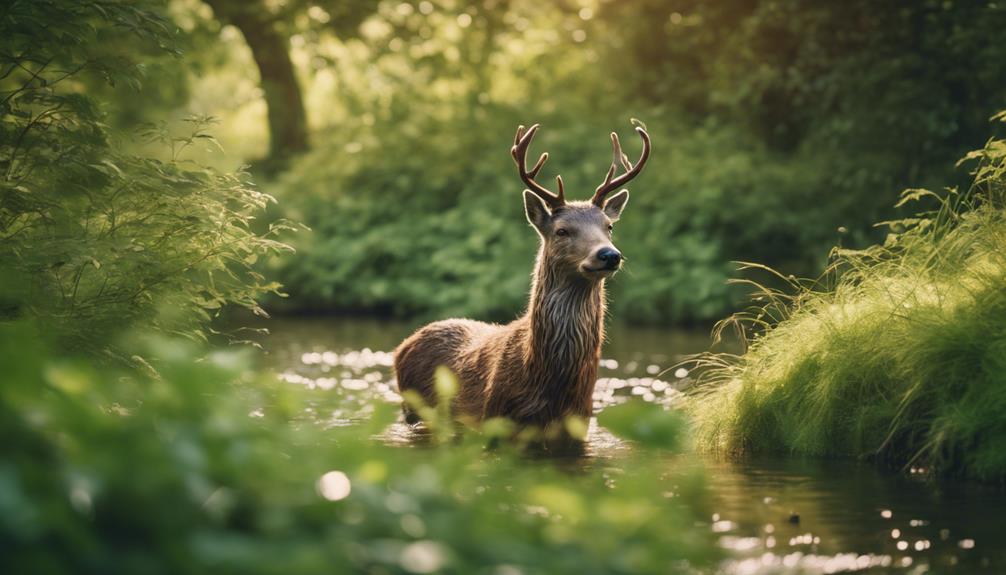
While bird watching offers a feast for the eyes, Staffordshire's diverse landscapes also provide fantastic opportunities for mammal photography. Imagine wandering through the lush woodlands, your camera ready to capture the graceful movements of deer or the playful antics of foxes. Staffordshire's rich biodiversity guarantees that you'll encounter a variety of habitats, perfect for woodland photography.
Understanding wildlife behaviour is key when photographing mammals. Knowing the habits of nocturnal creatures like badgers can help you anticipate their movements and capture that perfect shot. Keep an eye out during dusk and dawn when these elusive animals are most active.
Experienced wildlife photographers in Staffordshire can guide you to the best locations and offer tips on techniques, making sure you make the most of your photographic adventures. Plus, the ongoing conservation efforts in the region mean that these opportunities are sustainable, contributing to the protection of these magnificent mammals.
- Foxes: Seen in both rural and urban settings, they offer great opportunities for capturing movement.
- Deer: Often found in open fields or forest edges, their majestic presence makes for stunning images.
- Badgers: Primarily nocturnal creatures, they're best photographed in low light conditions.
Insect Macro Shots
Capturing the intricate details of insects through macro photography offers a fascinating glimpse into a hidden world. You'll find Staffordshire an ideal location for this type of photography, rich with insect life waiting to be discovered.
To get started, you'll need a macro lens to achieve the necessary magnification. Patience is vital, as insects can be quick and elusive. Observing their behaviour closely will help you anticipate their movements.
Lighting techniques are essential in highlighting the intricate textures and details of your subject. Natural light is often best, but you can use diffusers or reflectors to control harsh shadows.
For composition tips, try filling the frame with your subject while keeping the background simple. This approach keeps the focus on the insect's fine details.
Experimenting with unique angles can make your shots stand out. Get down to the insect's level or shoot from above to capture different perspectives. Using creative backgrounds such as colourful flowers or leaves can add a vibrant touch to your images.
Plant Photography Opportunities
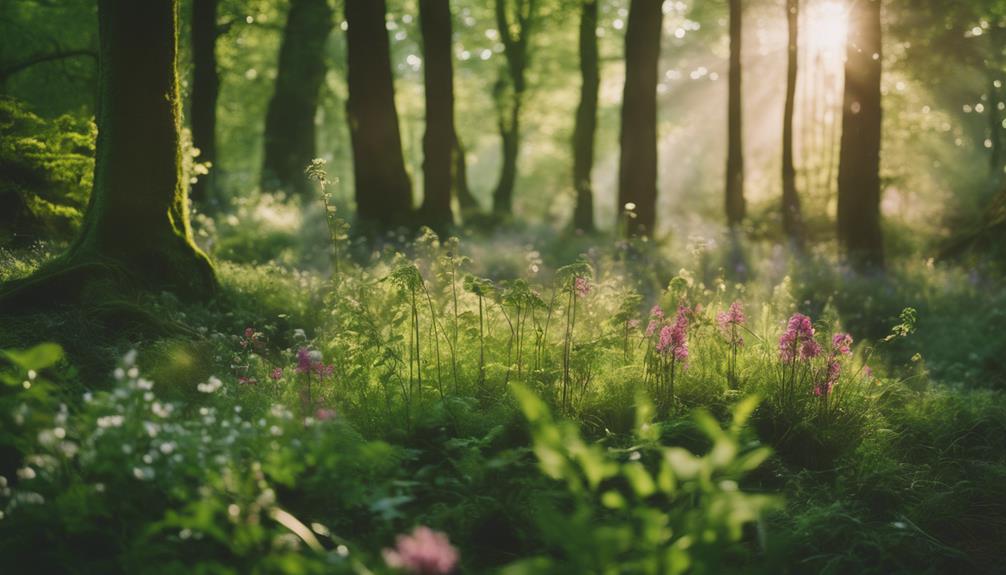
Staffordshire's diverse array of plant species offers countless opportunities for enchanting photography, from vibrant wildflowers to majestic trees. You can capture the essence of nature in the county's botanical gardens, where floral close-ups reveal intricate details and stunning colours. These gardens are perfect for immersing yourself in a tranquil environment while honing your skills in plant life portraits.
Natural reserves and parks in Staffordshire provide ideal settings for capturing plant life in various seasons. You can explore woodlands, meadows, wetlands, and gardens to find the perfect backdrop for your environmental landscapes. The rich biodiversity guarantees you'll always have new and exciting subjects to photograph, whether it's a rare flower or an ancient tree.
Photographers in Staffordshire have the chance to build a unique portfolio that highlights the beauty and variety of plant life. With so many locations to explore, you'll find endless inspiration and a sense of belonging within the local photography community. So grab your camera and start capturing the natural splendour that Staffordshire has to offer.
- Botanical gardens: Perfect for capturing detailed floral close-ups.
- Natural reserves: Ideal for seasonal plant life portraits.
- Woodlands and meadows: Great for environmental landscapes showcasing diverse plant species.
Frequently Asked Questions
Which Course Is Best for Wildlife Photography?
You should select a course that provides top-quality equipment options and takes into account seasonal variations to capture wildlife at its finest. Seek out community-oriented programmes that help you feel like a valued member of a committed group of photographers.
How Much Do Wildlife Photographers Make in the UK?
You can expect wildlife photographers in the UK to make between £18,000 and £60,000 annually. Earnings potential grows with experience and success, making this career ideal for those passionate about nature and seeking ongoing career growth.
Who is the world's best wildlife photographer?
You might think the world's best wildlife photographer is subjective, but Frans Lanting stands out. His mastery of camera equipment and commitment to ethical practices make his work resonate deeply, fostering a sense of connection and belonging.
Who is the famous English wildlife photographer?
When thinking of famous English wildlife photographers, you might first consider David Attenborough or Chris Packham. However, David Yarrow stands out with his mesmerising images and dedication to conservation, making him a celebrated figure worldwide.
Conclusion
Choosing Staffordshire for wildlife photography offers you a rich variety of habitats and opportunities. From the diverse landscapes of the Peak District and Cannock Chase to the tranquil nature reserves, wetlands, and woodlands, there's something for every photographer.
You'll find excellent spots for bird watching, mammal photography, and capturing insect macro shots. Plus, the plant photography opportunities are abundant. Staffordshire provides an ideal setting to enrich your wildlife photography portfolio.
